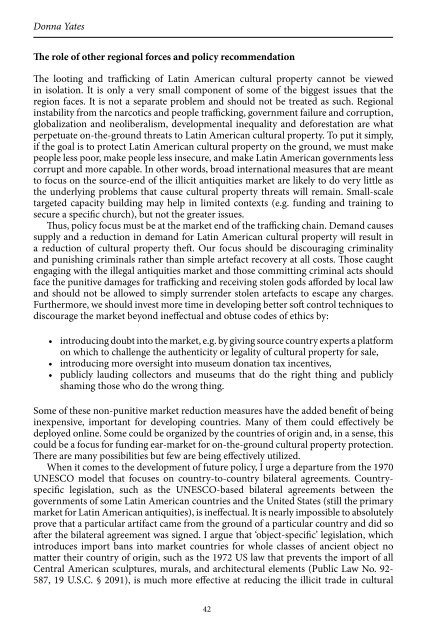Countering
Book_observatory_illicit_traffic_version%20issuu
Book_observatory_illicit_traffic_version%20issuu
You also want an ePaper? Increase the reach of your titles
YUMPU automatically turns print PDFs into web optimized ePapers that Google loves.
Illicit Trafficking in Latin America<br />
property and is cheaper to enforce as specific country of origin need not be specifically<br />
determined in each case. As we see, the UN is moving to impose more country-specific<br />
bans on the movement of antiquities, I fear that we will not move away from the countryspecific<br />
model and that our international policy efforts will continue to have little effect.<br />
Finally, more empirical academic research must be conducted on many of the<br />
unanswered questions involved in the theft, trafficking, and market for Latin American<br />
material. For example, there has been almost no research into sacred art theft and<br />
trafficking in any discipline: it is happening but we do not know how or why. Nonacademic<br />
reports may tie theft and destruction of many types of Latin American<br />
antiquities to encroachment and land clearings in protected areas, which itself is tied<br />
to complicated issues related to poverty, post-conflict, and other criminal trafficking<br />
activities. No academic work has focused on this. This is quite clearly due to a lack of<br />
sustained funding for this sort of research, both in Latin America and abroad. This lack<br />
of investment in primary research into the topic will likely ensure that most efforts to<br />
control cultural property trafficking are both ill-advised and ill-suited for the realities of<br />
the situations in which they will be applied.<br />
Acknowledgements<br />
The author has received funding for this research from the European Research Council<br />
under the European Union’s Seventh Framework Programme (FP7/2007–2013)/erc<br />
Grant agreement no. 283873 GTICO, the Leverhulme Trust, and the Fulbright Program.<br />
References<br />
Alva, Walter. 2001. ‘The Destruction, Looting and Traffic of the Archaeological Heritage<br />
of Peru’. In Trade in Illicit Antiquities: the Destruction of the World’s Archaeological<br />
Heritage, edited by Neil Brodie, Jenny Doole, and Colin Refrew (Cambridge:<br />
McDonald Institute of Archaeology), pp. 89-96.<br />
Arnold, John. 2004. ‘Seized Altar Languishes as Evidence in El Paso’. In Albuquerque Journal,<br />
1 August 2004. URL: < http://perma.cc/VX8K-T8UD > and URL: < http://web.archive.<br />
org/web/20150216195414/http://abqjournal.com/news/state/205578nm08-01-04.htm ><br />
[accessed 16 February 2015].<br />
Atwood, Roger. 2004. Stealing History: Tomb Raiders, Smugglers, and the Looting of the<br />
Ancient World (New York: St. Martin’s Press).<br />
Bruhns, Karen O. and Kelker, Nancy L. 2009. Faking the Ancient Andes (Walnut<br />
Creek: Left Coast Press).<br />
Coe, Michael. 1993. ‘From Huaquero to Connoisseur: The Early Market in Pre-<br />
Columbian Art’. In Collecting the Pre-Columbian Past, edited by Elizabeth Hill Boone<br />
(Washington D.C.: Dumbarton Oaks), pp. 271-290.<br />
Coggins, Clemency C. 1969. ‘Illicit Traffic of Pre-Columbian Antiquities’. In Art Journal<br />
29(1), pp. 94-114.<br />
Coggins, Clemency C. 1976. ‘New Legislation to Control the International Traffic in<br />
Antiquities’. In Archaeology, 29(1), pp. 14-15.<br />
Coggins, Clemency C. 1998. ‘United States Cultural Property Legislation: Observations<br />
of a Combatant’. In International Journal of Cultural Property, 7(1), pp. 52-68.<br />
Coleman, Michael. 2005. ‘Stolen Artifact Heads Home: Peru Altarpiece Recovered in<br />
City’. In Albuquerque Journal, 27 July 2006. URL: < http://perma.cc/E9FN-H3FD ><br />
43


